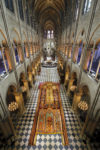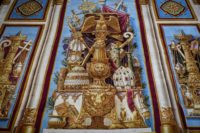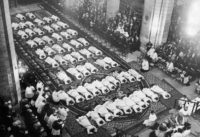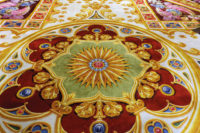 A monumental royal tapestry that once adorned the choir of Notre Dame has pulled through the cataclysmic fire that destroyed its roof this year thanks to the quick response of conservators and extraordinary measures taken to prevent its ruination.
A monumental royal tapestry that once adorned the choir of Notre Dame has pulled through the cataclysmic fire that destroyed its roof this year thanks to the quick response of conservators and extraordinary measures taken to prevent its ruination.
At 82 feet long and 24 feet wide, the tapestry covers more than 2000 square feet, the entire length of the cathedral’s choir. It was commissioned by King Charles X in April 1825 especially for the choir of Notre Dame. It was woven by the prestigious Savonnerie manufactory which had been Europe’s premier maker of knotted-pile wool carpets since the 17th century. Designed by Louis Saint-Ange Desmaisons, it is decorated  with a Gothic-style shrine filled with sumptuous liturgical objects — candelabra, crosses, lantern, censers, ewers, books — and in the central arch a pillar with the symbols of the four evangelists — the bull for Luke, lion for Mark, a youth for Matthew and the eagle for John — plus tiara, miter, stoles, holy water, cross, another censer, another books, a crook, candlesticks and more. Florals, crosses, urns, cornucopias, vines, grapes and a central sun embedded in a massive cross covers the rest of the vast piece in brilliant colors dominated by gold.
with a Gothic-style shrine filled with sumptuous liturgical objects — candelabra, crosses, lantern, censers, ewers, books — and in the central arch a pillar with the symbols of the four evangelists — the bull for Luke, lion for Mark, a youth for Matthew and the eagle for John — plus tiara, miter, stoles, holy water, cross, another censer, another books, a crook, candlesticks and more. Florals, crosses, urns, cornucopias, vines, grapes and a central sun embedded in a massive cross covers the rest of the vast piece in brilliant colors dominated by gold.
After Charles’ abdication in the wake of the July Revolution in 1830 and the election of Louis Philippe I as King of the French, the royal arms woven into the tapestry were deemed impolitic. They were replaced by the sun, bristling with rays, very distinctly unlike the ancient regime sun motifs, and flowers. The tapestry was completed in 1838 and donated to Notre Dame in 1841 on the occasion of the baptism of the king’s grandson Philippe of Orléans, Count of Paris.
 For decades the monumental tapestry was unrolled for use in major ceremonies, from the wedding of Napoleon III to Eugenie and the baptism of their son the imperial prince, to visits of dignitaries and special masses. By the late 19th century, however, it had been significantly damaged during restoration work on the cathedral and needed extensive repair. The Savonnerie manufacturers wove replacement panels and the repaired tapestry was once again deployed for an important function: the visit of Tsar Nicholas II and Tsarina Alexandra on October 7nd, 1896.
For decades the monumental tapestry was unrolled for use in major ceremonies, from the wedding of Napoleon III to Eugenie and the baptism of their son the imperial prince, to visits of dignitaries and special masses. By the late 19th century, however, it had been significantly damaged during restoration work on the cathedral and needed extensive repair. The Savonnerie manufacturers wove replacement panels and the repaired tapestry was once again deployed for an important function: the visit of Tsar Nicholas II and Tsarina Alexandra on October 7nd, 1896.
It was saved for extra special occasions after that. Fifty-eight deacons lay prostrate on its wool pile for their ordination in 1938. It got national exposure at the first televised mass at Notre Dame on Christmas of 1948. It was laid out in 1980 for the visit of Pope John Paul II. In January 2014, it was part of a special exhibition along with gold liturgical vestments and other precious objects given to the church by Charles X, Louis-Philippe and Napoleon III.
 Between these very, very rare unfurlings, the tapestry, in two pieces since the 19th century, was rolled up and stored in trunks on each side of the choir. When the roof of the cathedral ignited on April 15th, molten lead and burning timbers rained down into the church. The trunks kept the tapestry from being burned by the lead and wood, but they could not keep the water used to douse the fire from penetrating the wool fibers. When the tapestry was rescued from the rubble six days after the fire was extinguished, it weighed three tons. It weighed one ton before that horrific day. It had absorbed two tons of water as firefighters desperately struggled to control the inferno.
Between these very, very rare unfurlings, the tapestry, in two pieces since the 19th century, was rolled up and stored in trunks on each side of the choir. When the roof of the cathedral ignited on April 15th, molten lead and burning timbers rained down into the church. The trunks kept the tapestry from being burned by the lead and wood, but they could not keep the water used to douse the fire from penetrating the wool fibers. When the tapestry was rescued from the rubble six days after the fire was extinguished, it weighed three tons. It weighed one ton before that horrific day. It had absorbed two tons of water as firefighters desperately struggled to control the inferno.
With no time to waste, the tapestry was transported to the Mobilier National, the organization charged with conserving the nation’s furniture and art.
“Rolled up, it would have been a bacterial soup” that could have quickly started rotting, said Herve Lemoine, head of the Mobilier National.
“Once it was unrolled, we had to dry it in a huge wind tunnel and then freeze it to keep mould from developing,” Lemoine told AFP this week.
It was loaded into a large container whose temperature was gradually lowered to -35 degrees Celsius (-31 Fahrenheit) over a 24-hour period before it was brought to the Mobilier National’s labs in Paris.
The tapestry, still showing water damage and pre-existing issues like moth damage and tears, will briefly be unveiled for the public during an open house at the Mobilier National during the European Heritage Days on September 21st and 22nd.
Why is it called a tapestry and not a carpet?
Think of medieval Latin tapēta (‘wall covering’), but in fact ταπήτιον (tapḗtion) or τάπης (tápēs) really do mean ‘carpet’.
The distinction is that in ancient times, i.e. before ‘wall paper’ came into fashion, ‘wall carpets’ or tapestry was hung onto cold walls.
This example here seems to be one of the rare examples, where ‘tapestry’ was actually used on the floor.
In your last paragraph I read tears as crying real tears not rips in the tapestry. That seemed appropriate too.